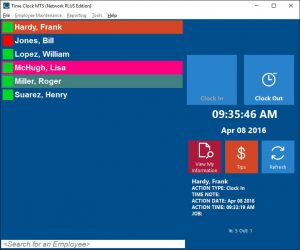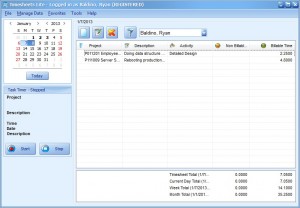There are three distinct reasons that an employer would have for using employee time tracking software such as Time Clock MTS or Timesheets Lite. These reasons are completely aside from the efficiency and productivity gains that employee time tracking software can deliver, but are more the basic reason why such software would be employed.
Basic Employee Hour Tracking
Every employer needs know how many hours an employee works during a payroll period and in some localities they need to know what days / times those hours are worked. Employee time tracking software must be able record employee hours, and then report on it in a timely fashion. Ideally the software should provide a number of different methods of recording the employee hours. This could be via use of a mouse and keyboard, a swipe card, a bar code scanner, touch screen integration, or an RFID scanner. All reports must be highly configurable, flexible, and able to be exported to a number of different formats or other software such as payroll software or costing software.
An ideal time tracking system will also provide an amount of post processing on recorded employee hours. This could include daily and weekly overtime calculations, sick time and vacation time accrual tracking, or even automatic break deductions. There may also be ancillary features to help streamline other business processes such as employee tip/gratuity tracking, employee time off requests, preventing employees clocking too early or too late, or even biometric security.
Internal Job Cost Tracking
It’s not at all unusual for a business to need to track the cost of internal jobs which will help ensure that jobs are both profitable and give some idea of when they are nearing completion. Employee hour tracking software must provide some means of allowing employees to both record their hours but also to allocate these hours to a particular job. It must do so with a minimum of fuss so as to not provide an administrative burden to the employees. Once the software is recording employee times against jobs it must also provide a means for management to track job labor costs via the reporting system. Again these reports must be able to be exported to a number of different formats, including being able to view job time reports in a spreadsheet program such as Microsoft Excel.
Recording Billable Hours
Many companies charge the hours their employees spend working on projects directly to their customers. Clearly in this case tracking billable hours is probably one of the most vital administrative tasks such a business can undertake. Employee time tracking software suited to this sort of environment must be particularly strong on the administrative side of the software. Projects that employees can book time to must be easy to create, must be able to have sub-tasks, must allow for budgets and budget tracking, and ideally should allow projects to be categorized. Reports for this sort of software should be much more project / budget focused rather than payroll focused. There must be reports to track project progress against budget, detailed reports showing fine grained detail of how employees have spent their time, and some basic payroll based reports such as a weekly timesheet. Again, as with any good time tracking software all reports should be able to be exported to a number of different formats.
Employee Time Tracking Software from Timesheets MTS Software
Timesheets MTS software has two employee time tracking software programs that are ideally suited to the cases I’ve discussed above. Time Clock MTS is a simple to use time clock program for employees show need to track their hours and record their time against jobs. It is particularly strong at tracking employee payroll hours and includes a number of payroll oriented features to help improve your payroll process. Timesheets Lite is a project based time tracking program for employees who need to continuously record their time spent on projects or even time their activities as they perform them.


